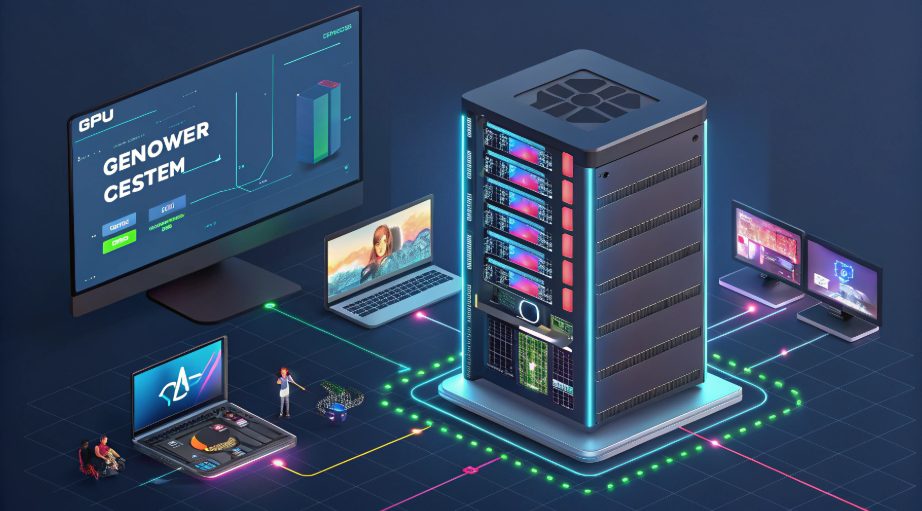How GPU Servers Empower Digital Content Creation

The landscape of digital content production is evolving at an unprecedented pace, driven by escalating demands for hyper-realistic visuals, complex simulations, and seamless user experiences. From 8K film sequences to open-world game environments and intricate 3D animations, the complexity of projects has outpaced the capabilities of traditional computing infrastructure. In this high-stakes arena, GPU servers have emerged as the backbone of efficient content creation, leveraging parallel processing architectures to tackle workloads that would cripple conventional CPU-based systems. For tech professionals navigating the intricacies of digital content pipelines, understanding the technical synergies between acceleration and content production workflows is critical. This article delves into how servers revolutionize key sectors of digital content creation, with a focus on the unique advantages offered by US-based GPU hosting solutions.
GPU Servers in Film Production: Beyond Traditional Rendering Limits
Film production, especially in the era of streaming giants and blockbuster franchises, demands unprecedented visual fidelity and rapid turnaround times. GPU servers address two critical pain points in this ecosystem:
- Real-time Rendering Architectures: Traditional CPU-based rendering farms operate on sequential processing, struggling with frame rates above 24fps for 4K footage. GPU servers, utilizing CUDA cores and tensor cores, parallelize pixel calculations. A single NVIDIA A100 GPU, for instance, can handle 5.3 TFLOPS of FP32 operations, enabling 8K real-time previews. This allows VFX supervisors to iterate on lighting scenarios and camera angles in live sessions, reducing revision cycles by up to 40%.
- Complex Effects Processing: Volumetric smoke simulations, particle-based explosions, and fluid dynamics—hallmarks of modern cinema—require massive computational throughput. GPU-accelerated physics engines like NVIDIA PhysX offload these calculations, processing 100,000+ particles per frame without latency. Post-production houses report a 65% reduction in time-to-delivery for effects-heavy sequences when migrating from CPU-only setups.
Game Development: Scaling Creativity with GPU Acceleration
Modern game engines like Unreal Engine 5 and Unity push hardware boundaries with features like Nanite virtualized geometry and Lumen global illumination. GPU servers act as force multipliers in three key development phases:
- Procedural World Generation: Open-world games with terabytes of assets rely on procedural algorithms. GPU servers with multi-GPU configurations (e.g., 8x NVIDIA RTX A6000) process heightmap data and texture synthesis in parallel, generating 100km² game worlds in hours versus days on CPU clusters.
- Ray Tracing Workflows: Real-time ray tracing in final builds depends on precomputed light caches. The servers accelerate lightmap baking by 300% using hardware-accelerated ray tracing cores, enabling developers to test dynamic lighting scenarios without sacrificing iteration speed.
- CI/CD Pipeline Optimization: Continuous integration for game builds involves automated testing across 1000+ hardware configurations. GPU-accelerated virtual machines (VMs) in US data centers reduce test cycle times by simulating multiple GPU architectures simultaneously, catching shader compilation errors early in development.
Animation Production: Redefining Character and Environment Design
3D animation studios face unique challenges in balancing artistic expression with technical feasibility. GPU servers streamline two critical workflows:
- Character Rigging and Simulation: Advanced character rigs with 500+ bones require inverse kinematics (IK) calculations for smooth movement. GPU-accelerated IK solvers process skeletal animations 15x faster than CPU equivalents, allowing animators to refine facial expressions and cloth dynamics in real time.
- Global Illumination Rendering: Path tracing algorithms for animation scenes (e.g., Pixar’s Renderman) benefit from GPU parallelism. A GPU server with 256GB VRAM can render a 4K frame with 10,000 light bounces in under 2 minutes, compared to 15+ minutes on a high-end CPU workstation.
Why US-based GPU Hosting Stands Out for Technical Teams
For technical professionals managing global content pipelines, US-based GPU server infrastructure offers distinct advantages:
- Low-Latency Global Connectivity: Tier-1 backbone networks in US data centers (e.g., Equinix IBX facilities) provide sub-50ms latency to EU and APAC creative teams. This is critical for collaborative projects using cloud-based render farms where real-time asset synchronization is mandatory.
- Power and Cooling Redundancy: US hosting providers typically deploy N+1 power architectures and liquid cooling for multi-GPU setups, ensuring 99.99% uptime. This eliminates render job failures during peak loads—a common issue in regions with inconsistent power grids.
- Developer Ecosystem Integration: Proximity to silicon valley tech ecosystems means US GPU servers often feature early access to driver updates and SDKs. For example, NVIDIA’s CUDA 12.x optimizations for media workflows were deployed on US servers 2–3 weeks before global rollouts, giving local teams a competitive edge.
Case Studies: Measurable Impact on Production Pipelines
- Independent VFX Studio: A 30-person studio specializing in indie film effects migrated to a US-based GPU server cluster (4x AMD Radeon Pro VII). Their render times for 10-minute 4K sequences dropped from 18 hours to 2.5 hours, enabling them to take on 3x more projects annually.
- Mid-tier Game Developer: Using a US colocation facility with 16x NVIDIA H100 GPUs, the studio reduced their open-world terrain generation time from 3 days to 14 hours. This allowed their level design team to iterate on 5x more environment concepts during pre-production.
- Animation House: By leveraging GPU-accelerated IK solvers on US-hosted servers, the studio cut character animation approval cycles by 40%, meeting Netflix’s tight delivery deadlines for a 12-episode series.
Conclusion: Future-Proofing Content Creation with GPU Servers
As digital content production continues to push boundaries—with 8K video, photorealistic VR experiences, and metaverse-ready assets—The servers are no longer optional but essential. The technical advantages in parallel processing, real-time feedback, and workflow acceleration directly translate to competitive advantages for studios and developers. US-based GPU hosting, with its robust infrastructure, low-latency connectivity, and integration with cutting-edge developer tools, emerges as a strategic choice for technical teams aiming to scale their creative output. For professionals tasked with optimizing production pipelines, investing in GPU-accelerated infrastructure isn’t just about faster renders—it’s about unlocking new creative possibilities that were previously computationally infeasible. In the race to deliver next-generation digital content, GPU servers aren’t just tools; they’re the foundation of tomorrow’s media landscape.

